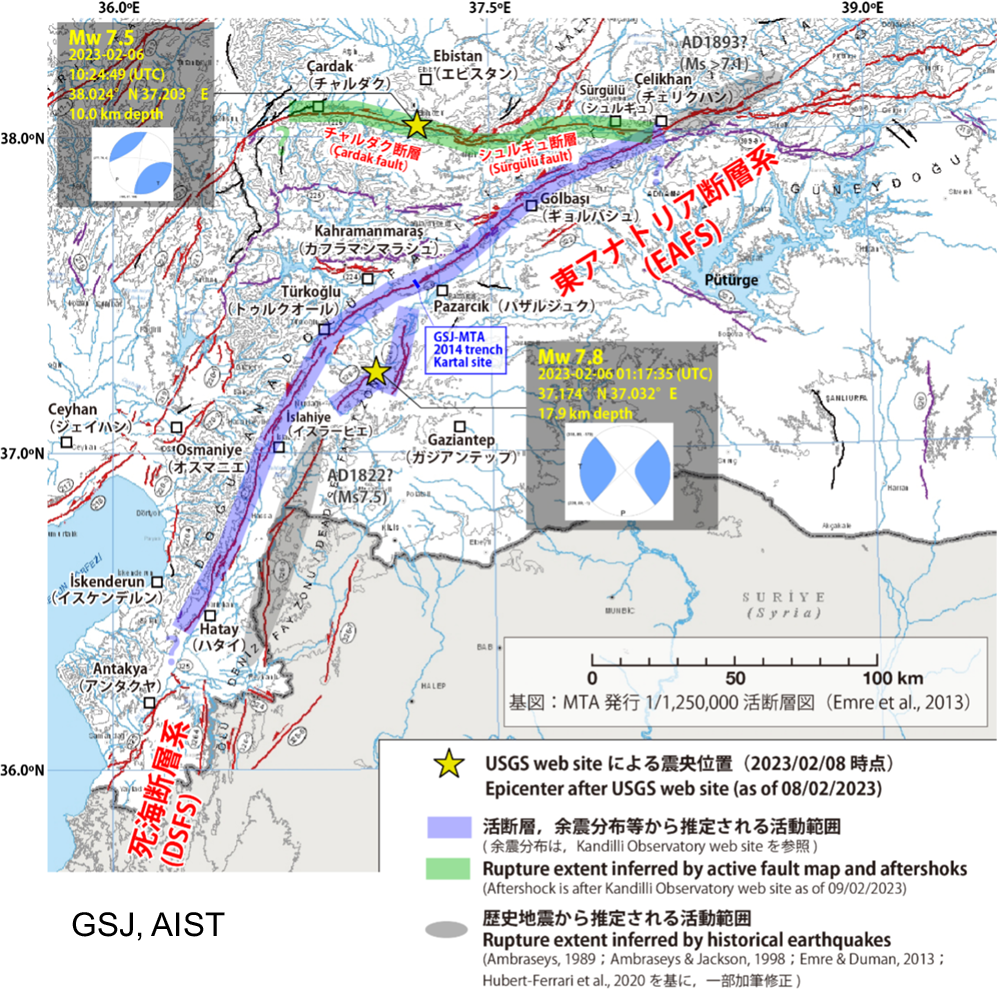Release date: February 13, 2023(JST)
update: September 20, 2023(JST)
Destructive earthquakes in southern Turkey on 6th February 2023 (Mw7.8 and Mw7.5)
At 1:17 A.M. (UTC), on 6th February in 2023, a destructive earthquake occurred on the southern section of the East Anatolian fault system (EAFS). USGS has reported immediately after the occurrence of the earthquake, that the magnitude was estimated to be Mw7.8 and the epicenter was located at the depth of 17.9 km. 9 hours later, at 10:24 A.M. on the same day, about 200 km north from the Mw7.8 event, another destructive earthquake occurred on the EAFS. The magnitude was estimated to be Mw 7.5, and the epicenter was located at the depth of 10 km. The focal mechanism reported by USGS implies that the complexed rupture extended during the individual earthquakes."
The sixth report "Primary surface rupture and slip distribution associated with Mw7.8 and Mw7.5 earthquakes in southern Turkey" [March 20, 2023]
The fifth report "Primary surface rupture and slip distribution associated with Mw7.8 earthquake in southern Turkey" [March 9, 2023]
The second report "Preliminary report on surface ruptures associated with Mw7.8 and Mw7.5 earthquakes in southern Turkey" [February 22, 2023]
First report [February 13, 2023]
Mapped active faults and the estimated rupture sections
KONDO Hisao and IMANISHI Kazutoshi Research Institute of Earthquake and Volcano Geology
Geological Survey of Japan, AIST
We preliminarily compared pre-existing active fault map with mainshocks and aftershocks distribution, and historical earthquakes (Fig. 1). The length of the source fault during the Mw 7.8 earthquake is probably for about 250 km long, whereas the length of the source fault during the Mw 7.5 earthquake is probably for about 130 km long. The epicenter of Mw7.8 event is located at almost middle of the entire rupture section, and the rupture bi-laterally extended to the north-east and to the south, respectively. The epicenter of Mw 7.5 is also located at the middle of the ruptured area. The Çardak fault and the Sürgülü fault has ruptured during this event, and those faults consist of branch faults of the EAFS. The fault section from Çelikhan to Türkoğlu seems to have ruptured in AD 1513 based on historical records, and the section was pointed out as one of seismic gaps along the EAFS. (e.g., Duman and Emre, 2013,Hubert-Ferrari et al.,2020). From now on, detailed interpretation of InSAR analysis and extensive mapping of surface ruptures in the field would help to confirm the length of the ruptured sections during the two destructive events.
Fig. 1 The epicenter of two destructive earthquakes, mapped active faults, and the estimated rupture sections. The location of epicenter and focal mechanism is after USGS website as of 9th February in 2023. The base map of active fault distribution is after 1/1,250,000 active fault map produced by MTA (Emre et al., 2013).
References
- Ambraseys, N.N., (1989) Temporary seismic quiescence: SE Turkey. Geophysical Journal International 96 (2), p. 311–331.
- Duman, T.Y., Emre, Ö., (2013) The East Anatolian Fault: geometry, segmentation and jog characteristics. Geological Society of London Special Publication 372 (1), p. 495–529.
- Emre, Ö., Duman, T.Y., Özalp, S., Elmacı, H., Olgun, Ş. and Şaroğlu, F., (2013) Active Fault Map of Turkey with and Explanatory Text. General Directorate of Mineral Research and Exploration, Special Publication Series-30. Ankara-Turkey.
- Hubert-Ferrari, A., Lamair, L., Hage, S., Schmidt, S., Çağatay, N., Avşar, U. (2020) A 3800 yr paleoseismic record (Lake Hazar sediments, eastern Turkey): Implications for the East Anatolian Fault seismic cycle, Earth and Planetary Science Letters, 538, doi.org/10.1016/j.epsl.2020.116152
- USGS web site, https://www.usgs.gov/programs/earthquake-hazards/earthquakes(Accessed: February 9, 2023)
- Kandilli observatory web site, http://udim.koeri.boun.edu.tr/zeqmap (Accessed: February 9, 2023)
Updates
- 2023.9.20: Additional interpretation about Fig. 2 in the 5th and 6th report have been updated.
- 2023.4.6: Additional interpretation and Figures in the 6th report have been updated.
- 2023.3.20: "Primary surface rupture and slip distribution associated with Mw7.8 and Mw7.5 earthquakes in southern Turkey" released; Pages
- 2023.3.9: "Primary surface rupture and slip distribution associated with Mw7.8 earthquake in southern Turkey" released; Pages
- 2023.2.22: "Preliminary report on surface ruptures associated with Mw7.8 and Mw7.5 earthquakes in southern Turkey" released; Pages
Contact: Geological Survey of Japan, AIST
Geological Survey of Japan, AIST
- About GSJ
- Our Activities
- Purchase guide
- Publications and Database
-
Geological Hazards
- Earthquake Hazards
- Volcanic Hazards
- Learning and Education
- GSJ Database Collection
- Collection of links


